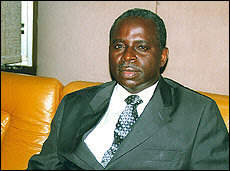 An economy easily accessible to foreign investors An economy easily accessible to foreign investors |
With the support of donors Côte d'Ivoire is now at the peak of completing its trade liberalisation programme. Reforms centered on the Competitive Sectoral and Structural Adjustment Programme, PASCO, are aimed at opening up the economy with the adoption of changes already existing in the international economic environment. So far, the liberalisation does not affect petroleum products and clothing containing at least 82% cotton.

Importation of petroleum products (crude oil, aircraft fuel, diesel oil, DDO etc. ) similar to those produced by the Ivorian Refinery Corporation, SIR, must be done with prior authorisation by Government. Importation of cotton materials which are under restriction and said to be regulated could only be finally liberalised when the restructuring of the cotton sector ends. The importation of products such as condensed milk, rice, flour, mineral and natural water and disposable wrapping bags whose importation had earlier been curtailed have now been liberalised.
Trade liberalisation started in 1991 has now entered its final phase. The impact of this programme has been the development of exports and imports. Ivorian exports thus represented 43% of the GDP in 1997 as against 27% in 1990. With regards to the trade balance, to CFA F 820 billion in 1997 as against CFA F 265.33 billion in 1990. During the same period, the value of imports increased from CFA F 1,056 billion to CFA F 1,598 billion.
The Government's foreign trade policy is based on economic liberalisation. The objective is to arrive at a point whereby the country could export about 60% of its products between 2000 and 2005. Within this export structure, it is about making the percentage of manufactured products exceed 51% and stabilise at 60% by 2000 and 80% by 2005.
Côte d'Ivoire resolved to develop the foundation of its exports since the devaluation of the CFA francs through diversification and the creation of an important added value. Côte d'Ivoire laid emphasis on the diversification of food production in order to respond to the demand from the West African subregion. The country's commercial strategy is centered on the Association for Export Promotion (APEXCI) which offers assistance to enterprises involved in shared-cost schemes in addition to chambers of commerce and agriculture, associations and professional organisations who equally assist in this commercial expansion policy.
Thus, there are partnerships with France's chambers of commerce and industry and their Candian and British counterparts in order to facilitate access to the Ivorian market. Ivorian exports towards the United States rose from CFA Francs 32.8 billion in 1982 to CFA francs 234 billion in 1998. Concerning exports they reached CFA francs 87 billion in 1998 representing an increase of more than 23.7% compared to the previous year.
Aside from the strong points in agricultural production, Abidjan remain the hub of maritime transport because the Abidjan Port is a major trans-shipment harbour in sub-Saharan Africa. Each year, there are 15 million tonnes of goods transported through this port including the entire exportable coffee and cocoa productions.
The coffee-cocoa sector remains the bedrock of export
in Cote d'Ivoire. Its liberalisation which began
in 1990 in the form of the "Agricultural Sector
Adjustmen Loan", (ASAL), became a reality only
in 1999 with the State's disengagement from the
cocoa sector. The coffee sector became liberalised
during the 1998-1999 farming year. For decades,
the Caisse de Stabilisation (CAISTAB) had
played a paramount role in this sector. Established
to stabilise prices, CAISTAB
was to ensure that producers enjoy stable and consistent
revenue. In the wake of the crises of the 1980's,
donor agencies had requested the Ivorian Government
to liberalise this sector starting from the early
1990's. Since the fund could no longer sustain prices
at their lowest levels, voices were raised as to
the efficiency of CAISTAB's role. Today, Managers
of this institution believe that even if CAISTAB's
resources were not wholly allocated to serve the
original purpose, these funds allowed for the realisation
of reliable infrastructures. |
Côte d'Ivoire exports 1.1 million tonnes of cocoa and 300,000 tonnes of coffee. These are key products for the country and as such, failure in this liberalisation process, is almost not allowed.
For the time being, a number of rules must be applied in the liberalisation process as Côte d'Ivoire should avoid what happened to Brazil as a result of liberalisation. In fact, Brazilian production is now controlled by big enterprises with the small producers starting to disappear since they were absorbed by the international groups.
Confronted with this threat, the Government has requested the small producers to form co-operatives. To this end, a co-operative legislation has been adopted to facilitate their integration into the coffee-cocoa sector. The law would favour any co-operative that produces 5,000 tonnes of produce and is made up of a CFA F 50 million capital guaranteed by a bank deposit of CFA F 25 million. For the 1999-2000 farming year, the co-operatives received CFA F 20 billion as back-up measures to sustain them. The CAISTAB has however released CFA F 6 billion for sustaining the Organisations Professionnelles Agricoles (i.e. Professional agricultural organisations), OPA. The new legislation enables the co-operatives to export their products without passing through intermediaries. The CAISTAB regularly keeps the agricultural community informed through the PRIMAC, its information programme on the coffee and cocoa market.
Nevertheless, it became necessary to carry out tours and information campaigns to let farmers know how to use this price because it is not a C.I.F price (international price) on the London market, which they ought to charge on their farms. According to a CAISTAB study, producers could have between 62% and 69% of the C.I.F price for coffee and between 50% and 60% of this price for cocoa.
Côte d'Ivoire imports half of its rice consumption which is about 200,000 tonnes of its annual rice cargo. Ever since its liberalisation in 1996, companies in this sector have been importing rice from abroad, especially from the United States, Thailand, Vietnam, etc.

The Compagnie Generale de Cote d'Ivoire, COGECO, was incorporated in 1997. Two years after its creation, COGECO has now become the second largest importer behind Côte d'Ivoire Trading the industry leader, in the rice business with a turnover of CFA F 28 billion in 1998. One must realise that 90% of the turnover is from the rice business and 75% of this figure is realised in Côte d'Ivoire while 15% is in countries in the sub-region namely Burkina Faso and Mali. COGECO does not distribute rice to the interior parts of the country but depends on a network of wholesalers and semi-wholesalers, or even the big institutional enterprises like SIFCA and CDCI a subsidiary of Blohorn (Unilever).
The company sells nearly 110,000 tonnes of rice every year representing 22% of the market. The specific aspect of this market is such that there are four leading companies in this sector which includes the Ivorian subsidiary of the American company, Glincor. Occasional importers share a small percentage of the market. For COGECO, American rice technology could be beneficial to Africa provided that technology transfer is allowed to take place. COGECO does not import American rice even where it may be more stable in terms of quality and nutritional value because on the average, it is between $50 and $100 above the price of Asian rice. This is why the company obtains its supply from China, Vietnam, Thailand, Pakistan and India. |

